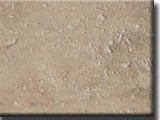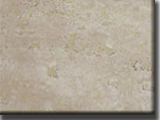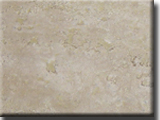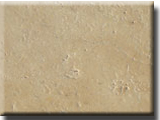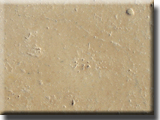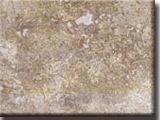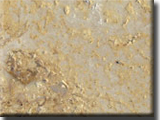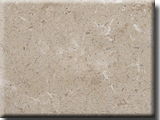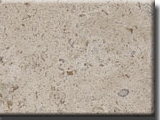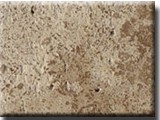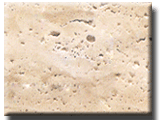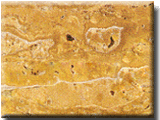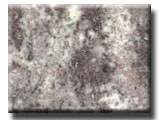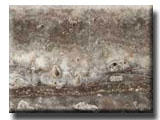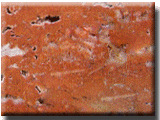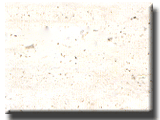Travertine and Limestone color
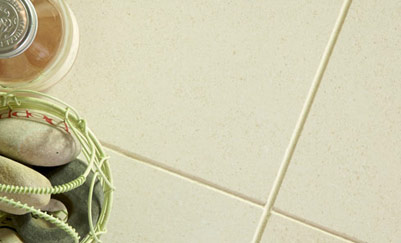 Travertine
Travertine is a type of natural stone formed through massive calcium carbonate, CaCO3, and resulting from deposition by springs or land rivers. Travertine is very porous but consists of very fine grains, often carries beautiful banded colors as the result of presence of iron compound or other impurities such as organics.
Travertine stone, sometime being called "travertine marble", "
travertine limestone" or even travertine granite, is also known as calc-sinter and calcareous tufa; when used for decorative purposes, it's often referred as onyx marble and Mexican onyx. Another nickname for travertine is "Egyptian Oriental alabaster".
Travertine color has significant variations within the same slab even the same tile, but in general can be categorized into beige cream or yellow (Chinese), gold and yellow (Turkish), walnut, noce or noche, light white or ivory and red travertine (Turkish).
Travertine can be used for building applications such as fabricating floor tiles, wall tiles, countertops. Certain types are available for carving sinks, tables, fireplace mantel surrounds, columns, gazebos, fountains, statues etc. Visit our "travertine for carving" page for detail. Other uses of building travertine include luxury decorations like floor medallion, mosaic in the areas requiring strong natural ascents. We supplies the following custom travertine colors:
Travertine and Limestone
Types
Unfilled: Travertine with naturally occurring holes.
Filled: Travertine with its naturally occurring holes filled with a mixture of a hardener and dust obtained from the cutting and honing process.
Polished: During production, a facet is put on each crystal at a microscopic level – much as a jeweler would facet a diamond. The resultant smooth surface allows light to refract in and out of the stone in a parallel way. This enhances the visible sheen and gives the appearance of depth.
Honed: A smooth, non-reflective finish achieved by grinding the surface.
Saw Cut: The untreated surface of a stone when it is first cut. The surface is slightly rough
Tumbled (ancient stones): An antique look achieved by rounded corners and edges.
Special Considerations
Color variations are common and enhance the natural beauty of travertine. Be sure to inspect multiple samples of the stone before selection to ensure satisfaction with colors and patterns.
Maintenance
Do clean with a dust mop and neutral cleaner to remove most dirt.
Do use a penetrating sealer to prevent staining. Because many stones are porous to some degree, excessive water may cause reactions such as oxidation (rust), spalling, deterioration of dry veins, etc. “Special Impregnating” sealers are recommended to avoid these problems. Emser representatives can recommend appropriate sealers.
Do clean natural stones with “special stone cleaners”, “pH balanced cleaners” or “neutral base cleaners.”
Do not clean any natural stone with acidic cleaners, including (but not limited to) vinegar or cleaners with “lemon” or “lime” on the label. These products will abrade the polish from the stone. Sealers DO NOT protect polished surfaces from these types of cleaners.
 Travertine is a type of natural stone formed through massive calcium carbonate, CaCO3, and resulting from deposition by springs or land rivers. Travertine is very porous but consists of very fine grains, often carries beautiful banded colors as the result of presence of iron compound or other impurities such as organics. Travertine stone, sometime being called "travertine marble", "travertine limestone" or even travertine granite, is also known as calc-sinter and calcareous tufa; when used for decorative purposes, it's often referred as onyx marble and Mexican onyx. Another nickname for travertine is "Egyptian Oriental alabaster". Travertine color has significant variations within the same slab even the same tile, but in general can be categorized into beige cream or yellow (Chinese), gold and yellow (Turkish), walnut, noce or noche, light white or ivory and red travertine (Turkish). Travertine can be used for building applications such as fabricating floor tiles, wall tiles, countertops. Certain types are available for carving sinks, tables, fireplace mantel surrounds, columns, gazebos, fountains, statues etc. Visit our "travertine for carving" page for detail. Other uses of building travertine include luxury decorations like floor medallion, mosaic in the areas requiring strong natural ascents. We supplies the following custom travertine colors:
Travertine is a type of natural stone formed through massive calcium carbonate, CaCO3, and resulting from deposition by springs or land rivers. Travertine is very porous but consists of very fine grains, often carries beautiful banded colors as the result of presence of iron compound or other impurities such as organics. Travertine stone, sometime being called "travertine marble", "travertine limestone" or even travertine granite, is also known as calc-sinter and calcareous tufa; when used for decorative purposes, it's often referred as onyx marble and Mexican onyx. Another nickname for travertine is "Egyptian Oriental alabaster". Travertine color has significant variations within the same slab even the same tile, but in general can be categorized into beige cream or yellow (Chinese), gold and yellow (Turkish), walnut, noce or noche, light white or ivory and red travertine (Turkish). Travertine can be used for building applications such as fabricating floor tiles, wall tiles, countertops. Certain types are available for carving sinks, tables, fireplace mantel surrounds, columns, gazebos, fountains, statues etc. Visit our "travertine for carving" page for detail. Other uses of building travertine include luxury decorations like floor medallion, mosaic in the areas requiring strong natural ascents. We supplies the following custom travertine colors: